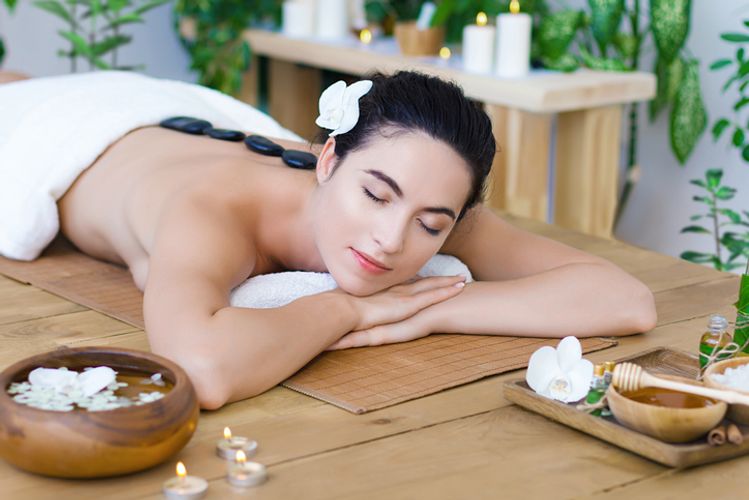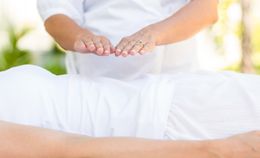Massage therapy is well-known for its ability to soothe and to heal, both physically and psychologically. Whether you are seeking a healthy way to unwind from the frantic, always-plugged-in pace of modern life or a safe and effective pain management strategy for a chronic health condition, there is more than likely a massage therapy program available to meet your needs.
Massage is a universally supportive and healthy means of self-care, providing both pleasurable pampering and clinically-proven health and wellness treatment.
Massage modalities can vary widely in how much they emphasize and target health benefits versus creating a relaxing or luxurious experience. But regardless of language and technique, the essence of massage, broadly speaking, is universal. The skilled, caring touch of a massage therapist can help put our bodies and our minds at ease, relieving pain and improving function and well-being. Massage helps us feel better and stay healthy.
Systems for the skilled manipulation of the body's soft tissue have been developed by various cultures and moments in history, resulting in an array of distinct types of massage. Each tradition frames its practice according to its own unique terms, understanding of the body and treatment goals. And each has developed its own specific manual treatment techniques - different ways of applying therapeutic pressure and strokes to the body.
Massage therapy today encompasses a diverse set of techniques that have emerged from these varying traditions. Many massage therapists are trained in a variety of massage modalities and may draw from them as needed, even in a single session, in order to best tailor their work to their clients' individual needs and preferences. Other massage practitioners prefer to work within a specific massage therapy tradition and in doing so, can introduce clients to the specific strengths of that modality.
In a previous guide, we explored the Hot Stone Massage, Sports Massage, Swedish Massage, Deep Tissue Massage and Trigger Point Therapy & Myofascial Release. This guide continues with a discussion of the different techniques and applications of:
- Aromatherapy massage
- Shiatsu massage
- Prenatal massage
- Reflexology
- Neuromuscular massage therapy
- Thai massage, also called Thai yoga massage
- Chair massage
1. Aromatherapy massage
Aromatherapy describes the use of scented essential oils in either lotion or oil that is applied to the body to reduce friction during massage. Aromatherapy is most often incorporated into a Swedish massage therapy session with the main goal of facilitating stress reduction and relaxation.
Aromatherapy adds to the manual therapy of massage the healing properties of specific botanical elements. For example, lavender and chamomile are both widely appreciated for their calming scents; they are also natural anti-inflammatories.1 A variety of different essential oils may be used to produce different benefits and experiences for the client.
Since aromatherapy massage incorporates lotion or oil it has the added benefit of moisturizing the skin. Many people find aromatherapy massage to provide deep relaxation.
2. Shiatsu massage
Shiatsu is a Japanese term meaning "finger pressure".
Like other Asian bodywork modalities with origins in Traditional Chinese Medicine, Shiatsu massage intervenes with the body's energy flows to restore balance and strength to the system. Strong and balanced energy flows tend to support overall health and wellness, whereas imbalances and blockages can cause illness and injury or inhibit recovery.
The massage therapist will focus on treating points along your meridians, or energy pathways, to remove blockages that may be causing an imbalance. In contrast to the long, gliding strokes of Swedish-style massage2, Shiatsu massage practitioners apply pressure in a rhythmic pattern using their fingers, palms and sometimes elbows,3 a technique that some clients find refreshing or invigorating.
Stretching is also often a feature of a Shiatsu massage session. Recipients of Shiatsu massage are treated fully clothed.
3. Prenatal massage
Prenatal massage therapy is aimed at best serving the needs of pregnant women.
This means addressing common pains and discomforts of pregnancy such as back, joint and leg pain, edema4 (swelling of the ankles and feet), and the reduction of stress and anxiety to improve mood and sleep, as well as physical modifications to typical massage therapy practices to accommodate a bulging belly. Bolsters and pillows are often used to prop a pregnant woman in a comfortable position on her side on the massage table during a session. A specialized pregnancy massage table may also be used.
Massage therapy is generally considered safe during pregnancy. However, because miscarriage is very common during the early months of pregnancy, many massage therapists choose not to practice at this time to avoid any appearance of a link in case this occurs. Others will provide massage services with a doctor's written permission and/or a signed waiver. Because pregnant women have increased overall blood volume and slower blood flow in the legs, they have an elevated risk of blood clots. For this reason, massage therapists typically avoid applying deep pressure directly to the legs to avoid dislodging any possible blood clots.5
Prenatal massage has been shown to effectively reduce the physical and emotional stress women experience during pregnancy.
4. Reflexology
Reflexology is a massage modality rooted in Traditional Chinese Medicine. It involves the application of pressure primarily to the feet, and sometimes the hands and ears as well.6 The therapist may use their hands as well as specialized tools depending on the Reflexology tradition they have trained in.
The concept behind Reflexology is that different pressure points on the feet correspond to organs and systems throughout the body.7 Reflexology aims to restore optimal function to the body as a whole by the application of manual therapy to the feet. Like other Asian bodywork modalities, Reflexology also promotes overall health and wellness by helping to restore and rebalance the body's energy flows (this energy is referred to as chi, qi or ki).
5. Neuromuscular massage therapy
Neuromuscular massage therapy is a special form of medical or therapeutic massage, meaning this modality prioritizes a therapeutic outcome over relaxation and pampering during the massage itself.
Neuromuscular massage therapists often have advanced training and a high-level understanding of postural alignment, body mechanics, and the complex interplay of the musculoskeletal system's different elements. They can treat common ailments such as carpal tunnel syndrome, back pain, sciatica, tendonitis, plantar fasciitis, headaches and simple muscle strain, among many others.
Neuromuscular massage focuses on targeted treatment of a patient's complaint, beginning with a thorough history and examination. Treatment often begins with the therapist placing the client's body in a series of passive positions,8 sometimes with the help of bolsters and pillows. This is a gentle yet effective way to begin releasing muscle tension. It can be an especially important first step in a session for clients with serious pain conditions, as it prepares their bodies to permit the application of manual pressure that they might otherwise find intolerable.
The massage therapist may employ some familiar Swedish massage movements, including sweeping massage strokes to warm up the body and rhythmic kneading and rolling of muscle and soft tissues to increase blood circulation. Massage techniques from other modalities may also be incorporated into the session depending on the therapist's training and the client's needs.
Neuromuscular massage emphasizes the release of myofascial trigger points, or tiny areas of muscle spasm and tight connective tissue that are often extremely sensitive and irritable to the touch. These areas are often deprived of adequate blood flow and therefore oxygen and nutrients, and can contain buildup of metabolic wastes such as lactic acid.9
Trigger points are released through alternating levels of sustained pressure; the therapist may use their knuckles, fingers, and elbows in the process and may apply pressure to a trigger point for 10 to 30 seconds.
Trigger point release is widely recognized for its effectiveness in reducing pain - both localized pain at the site of the knot and referral pain, weakness, and fatigue at remote locations in the body. It is credited as an especially effective regular treatment for chronic back pain.
A neuromuscular massage session can include assistive stretching techniques as well, to improve flexibility and range of motion.
6. Thai massage
Thai massage is also called Thai yoga massage, because of its use of assisted yoga-like stretch positions. This massage modality also incorporates pulling and rocking techniques, joint mobilization, and acupressure (sustained pressure to certain points on the body).10
Thai yoga massage is performed on a mat on the floor with the client fully clothed, in loose-fitting, comfortable clothing. The therapist uses much of their body - hands, elbows, knees, feet and legs - to adjust the client's body position, apply pressure, rock, pull, and otherwise manipulate the body.
Like Shiatsu massage and Reflexology, Thai yoga massage works through both physical and energetic pathways to relieve muscle tension and clear energy blockages, promoting overall health and well-being.11
Thai massage is a very effective treatment for pain relief from many chronic pain conditions. Joint mobilization in particular can help relieve inflammation in arthritis sufferers. Acupressure and muscle compression techniques can help with back pain and hip pain, sciatica, tendonitis, and more by breaking up adhesions, improving circulation and range of motion, and releasing muscle knots.
7. Chair massage
Chair massage offers an accessible introduction to the benefits of massage. The chair used in chair massage is usually a specialized one that allows you to rest your face comfortably in an upholstered support with your back exposed to the massage therapist.
Chair massages are often given in busy and public locations that otherwise wouldn't allow for massage on a treatment table, such as offices and malls.
Chair massages are usually relatively short and are given with the recipient fully clothed. The therapist focuses mostly on the upper back, neck and shoulders, and sometimes the lower back, arms, and hands as well.
Chair massages are many people's first experience with massage therapy and can be a great way to get a taste of the full benefits massage therapy has to offer
References:
1 "Aromatherapy massage":https://www.aromaweb.com/articles/aromatherapymassage.asp
2 "How Shiatsu Massage Therapy Balances Qi":https://www.amcollege.edu/blog/shiatsu-massage
3 "Massage Therapy Modalities: Shiatsu": https://massagetherapylicense.org/articles/shiatsu-massage.html
4 "Foot Massage Reduces Edema in Pregnant Women": https://www.massagemag.com/foot-massage-reduces-edema-in-pregnant-women-8111/
5 "Pregnancy Massage":https://www.webmd.com/baby/pregnancy-and-massage#2
6 "What is Reflexology?": http://www.americanacademyofreflexology.com/what-is-reflexology-definition-of-reflexology/
7 "What is Reflexology? It's More Than Just a Foot Massage!":https://www.spafinder.com/blog/healing/reflexology-101-treatment-benefits/
8 "The Massage Therapist's Guide to Neuromuscular Therapy": https://www.massagemag.com/guide-to-neuromuscular-therapy-119085/
9 "Neuromuscular Massage Therapy": https://www.spine-health.com/wellness/massage-therapy/neuromuscular-massage-therapy
10 "Thai Massage Technique and Benefits":https://www.verywellhealth.com/thai-massage-90010
11 "The Origins of Thai Yoga Massage":http://www.lotuspalm.com/thai-massage





















